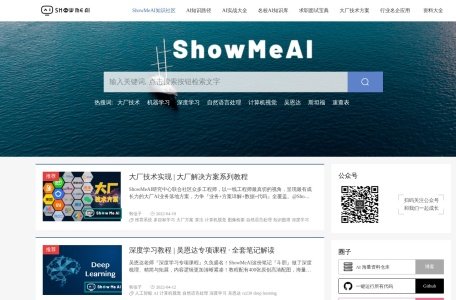
As an AI learner, have you ever struggled with fragmented courses, difficulty applying theory to practice, or no one to answer your questions? ShowMeAI Knowledge Community (official site: https://www.showmeai.tech) – a platform focused on artificial intelligence – solves these pain points. With over 100,000 practitioners, it centers on “structured content + practice-oriented learning + community ecosystem,” covering Python, machine learning, deep learning, and more. It has become the top learning destination for students, career changers, and corporate developers. This article, updated with 2025 features, breaks down why it stands as a “one-stop solution” for AI learning.
I. What Is ShowMeAI? Positioning & Core Value
ShowMeAI Knowledge Community is a comprehensive AI learning platform built by a professional team and senior engineers, positioned as the “encyclopedia of AI.” Unlike regular tutorial sites, it covers the full lifecycle of “learning → job hunting → development → decision-making,” integrating top university courses, enterprise technical solutions, and personalized learning paths. This solves the core issues of traditional platforms: scattered resources and a disconnect between learning and application.
As of October 2025, the platform has integrated 300+ structured courses, 22 industry-level cases, and 100+ open-source code repositories. It covers core fields like natural language processing (NLP) and computer vision (CV), and even extends to vertical scenarios such as fintech and biomedical engineering. Whether you’re a beginner or an advanced researcher, you’ll find a tailored growth plan here.
II. Core Features: End-to-End Support From Theory to Practice
ShowMeAI’s features directly address real pain points in AI learning, with every function designed to “master efficiently and apply practically”:
1. Structured Learning Paths: No More Aimless Practice
Its core advantage lies in learning frameworks built on knowledge graphs. Take the “Machine Learning Engineer Growth Path” as an example – it includes 12 modules (math fundamentals, algorithm principles, model deployment, etc.). Each module comes with video tutorials, code examples, and self-assessment questions, forming a closed loop of “input → practice → feedback.”
Paths are tailored to different user needs:
- Career Changers: Recommended “Python Basics → Machine Learning → Industry Cases” step-by-step courses;
- Students: Emphasis on “Math Enhancement → Algorithm Competitions → Research Papers.”
Eight themed mind maps (e.g., Stanford CS229 Math Cheat Sheet) help quickly organize knowledge logic.
2. Practical Project Workshop: Zero Barriers With Cloud-Based Tools
“Learning in theory only” is a major pitfall in AI education. ShowMeAI’s Practice Center offers 20+ real-scenario projects – from medical image analysis to e-commerce recommendation systems – covering the full workflow: data preprocessing, model training, and deployment.
The most user-friendly feature is the cloud-based Jupyter environment: No need to configure local computing power – write code online directly, and reference top solutions to reproduce results. Free users get 2 hours of daily GPU quota; paid members unlock more resources for easy training of small-to-medium projects. For example, the MovieLens Recommendation System project provides complete datasets and code templates, making it accessible even for beginners.
3. Top University & Enterprise Resource Library: Stand on the Shoulders of Giants
The platform integrates core resources from global top universities and companies:
- University Course Packages: 10+ core AI courses from Stanford, MIT, UC Berkeley, etc., with bilingual subtitles, slides, and homework explanations. It even includes 400 original illustrated notes for Andrew Ng’s Deep Learning course;
- Enterprise Solution Library: Official guides for Google TensorFlow, Meituan’s recommendation system optimization plans, etc. Senior engineers break down business logic and code implementation details.
These resources are reprocessed to boost efficiency compared to raw materials. For instance, Stanford CS224n notes add dynamic annotations to slides and code explanations for homework, making difficult concepts clear at a glance.
4. Intelligent Recommendations & Interaction: Personalized Learning Assistant
By analyzing user learning behaviors and career goals, the system dynamically adjusts recommended content. For example, if you frequently browse “large model deployment” articles, it automatically pushes PyTorch framework tutorials and Alibaba Cloud deployment cases.
Interactive tools make abstract knowledge tangible: In deep learning courses, a slider lets you adjust the number of neural network layers in real time to observe changes in model performance. The code editor supports online debugging, and an error diagnosis tool automatically generates optimization suggestions.
5. Active Community Ecosystem: Questions Answered Within 24 Hours
The 100k+ user community serves as a vital “knowledge supplement hub”:
- Q&A Plaza: Ask targeted questions like “How to improve model generalization?” Add an “Urgent Help” tag to get priority responses from experts within 24 hours;
- Featured Activities: Weekly “AI Paper Reading Sessions” attract global developers to interpret top conference findings; offline Meetups enable face-to-face exchanges.
Here, you not only solve problems but also build industry connections.
III. Target Audience: Who Grows Fast Here?
ShowMeAI is highly inclusive, with value for users of all backgrounds:
Students
Computer science students can enhance practical skills through Kaggle competition-style projects to prepare for research or jobs. Non-technical students can develop interdisciplinary competitiveness via courses like AI for Everyone.
Career Changers
Professionals in traditional industries (finance, healthcare) can learn vertical solutions (intelligent risk control, medical image diagnosis). For programmers switching to AI engineering: The platform’s PyTorch framework and large model deployment courses fill skill gaps precisely.
Enterprise & Research Professionals
Technical teams can reference industry-level cases to speed up project delivery. Managers use industry whitepapers to shape AI strategies. University researchers access latest paper interpretations and open-source tools to accelerate result translation.
IV. 2025 Quick Start Guide: 5 Steps to Double Efficiency
1. Registration & Path Initialization (5 Minutes)
Visit the official site to register. Fill in your professional background (e.g., “Zero-Basis AI Career Changer”) and learning goals – the system generates a personalized initial learning path. Email verification is recommended to unlock more free resources.
2. Beginner Breakthrough: 5-Day Starter Bootcamp
Prioritize the AI Basics Bootcamp in the “Beginner Zone” to quickly master Python programming, data processing, and machine learning fundamentals – laying the groundwork for further study.
3. Course Learning: Watch & Practice Simultaneously
Select a field from the navigation bar (e.g., “Natural Language Processing”). Each chapter includes videos, code examples, and homework. Use the right-side code editor to practice in real time; click “Live Q&A” if you hit snags.
4. Project Practice: From Imitation to Innovation
After finishing basic courses, enter the “Practice Center” to choose projects. Start with simple tasks like “Data Visualization Analysis”; once proficient, tackle enterprise-level cases like “Recommendation System Optimization.” Reference excellent solutions to refine your code.
5. Community Interaction: Accelerate Growth Through Active Sharing
Join “Study Groups” to collaborate on projects or answer questions in the Q&A Plaza. Sharing notes and code helps others while earning points to redeem course coupons.
V. Common Issues & Solutions
| Pain Point | Platform Solution |
|---|---|
| Beginners struggle with course difficulty | First take the AI Prep Course to strengthen math and Python basics; use the “Intelligent Difficulty Adjustment” feature to adapt dynamically |
| Lack of data & computing power | Download from the public dataset library; free users get 2 hours of daily GPU quota; paid members enjoy expansion |
| No answers to technical questions | Code diagnosis tool auto-fixes errors; “Urgent Help” tag triggers 24-hour expert responses |
| Low motivation to learn | Join “Check-In Challenges” to earn points; use group rankings to stay motivated |
Conclusion: The “Cost-Effective King” of AI Learning
ShowMeAI Knowledge Community’s core strength lies in integrating “authoritative resources, structured paths, practical environments, and community support” into a closed loop. Core courses are permanently free; paid memberships (including 1-on-1 guidance and enterprise referrals) meet advanced needs – balancing accessibility and professionalism.
If you’re stuck on “what to learn, how to learn, or how to apply,” give this platform a try. From Stanford course notes to Meituan’s practical solutions, from code debugging to community Q&A – it solves nearly every pain point in AI learning. After all, the key to efficient growth is choosing the right tool and staying consistent in practice.
Relevant Navigation


Google AI

Udacity AI School

AutoGLM

Trancy

Day of AI

Alibaba Cloud AI Learning Path

AI University Hall

